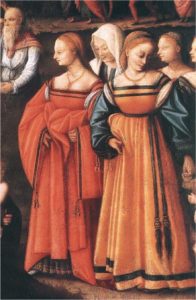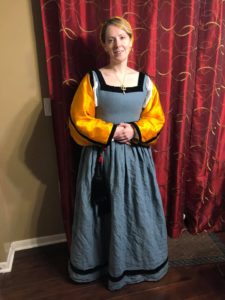I. Summary
This entry is a Florentine gamurra style dress with a hemp-stiffened bodice, detachable sleeves, and an underskirt with a stiffened hem in the doppia style.
Materials:
- 100% linen (dress, sleeve lining)
- 100% silk charmeuse (sleeves)
- 100% raw silk (underskirt)
- 100% wool felt (underskirt stiffening)
- 100% hemp cording (dress bodice)
- 100% cotton thread (stitches)
- 100% silk embroidery floss (eyelets)
- Nylon velvet trim (dress, sleeves)
The dress is primarily constructed with whip and back stitching, with running stitches used to attach trim and other minor parts which will not bear weight. It uses box and knife pleats for the skirt and underskirt. The dress is made of roughly five yards of linen, the underskirt over three yards of raw silk, and the sleeves are made of roughly 1.25 yards of silk with a similar amount of natural colored linen as lining.
The outfit is 90% hand-sewn. The only parts which are not are those relating to the stiffened part of the bodice, which were an experiment. The channels for the hemp cording, the stitches around the stiffened portion, and a small section of the shoulders were machine sewn. Everything else, as well as every part of the sleeves and the underskirt are sewn by hand.
II. Progress Pictures
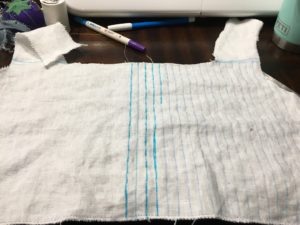
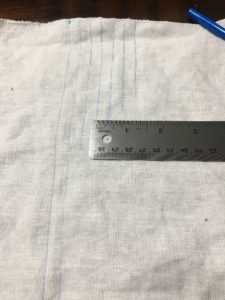
Figure 1 and 2: Drafting the channels
a. The Gamurra (Dress)
The bodice was draped onto the body using a modified pattern from Janet Arnold’s Patterns of Fashion 3. Once a suitable mockup had been made, a paper pattern was drawn. The pattern was used to cut out six pieces of linen: one front and back out of blue linen that would serve as the outer fabric, and four pieces of natural colored linen which would be used to construct the hemp stiffened parts of the bodice.
The stiffening is created by sewing channels, each just over ¼” wide, down the length of the bodice. These linen channels will hold the hemp in place, ultimately allowing the bodice to function as a supportive garment.
Once the channels are sewn, the hemp cords need to be threaded through them. In order to get the proper stiffening, 1/16th” hemp cord was doubled up and two such doubled strands were put in to each channel. Once they were in the channels the ends were cut, and the top and bottom of each bodice piece were sewn shut.
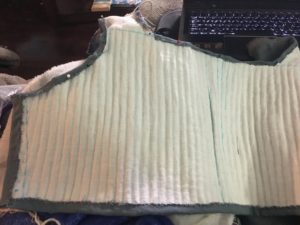
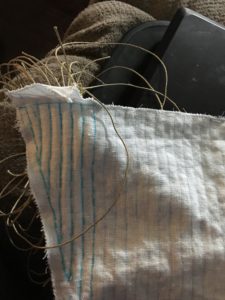
Once all of the channels were sewn shut, the sandwiched layers were sewn to the blue linen exterior of the bodice. This created the front and back of the bodice, which would later be sewn together at the shoulder to create one individual garment.
The end results can be seen to the right. The fit ended up right on, as did the look of the stiffening and the silhouette of the piece. The only issue was comfort, as the cording can be felt pushing up against the body. To combat this, additional layers of linen were added to sit between the hemp and the camicia.
The skirt of the dress is composed of two rectangular pieces of blue linen which are pleated directly onto the bodice. In the center of both the front and back bodice piece is a single box pleat which leads into 1 ¼” knife pleats. The bottom is hemmed using whipstitches.
The dress is closed using side-back lacing. Eyelets are handsewn using an awl to make the hole and silk embroidery floss for the eyelet. They are arranged in a pattern commonly referred to as “spiral lacing.” In keeping with what is commonly seen on Italian dresses of the period. Eyelets were also placed on the shoulders in order to be able to tie on the sleeves.

1 ½” black velvet trim was used as decoration on both the bodice and hem of the gown and was attached using running stitches. Velvet guards were a common decorative element in early 16th century Florentine fashion.
b. The Sleeves
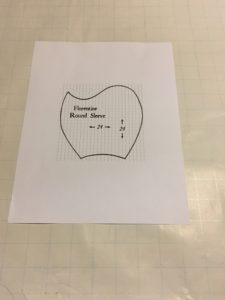
The sleeve pattern is adapted from a now defunct section of the Festive Attyre website. It’s one that I’ve used for some time because it matches the fit and look of the portraiture very well. The first pieces cut out were the linen linings, which were used to give the sleeves drape and durability. After that the silk charmeuse was cut.
The sleeve is bag-lined at the shoulders and then whipstitched at the wrists. While bag lining is a modern technique, it produced a sleeve that is in keeping with the silhouette of the time period. The raw seam edges were folded in on themselves and whipstitched together to prevent fraying. As with the dress, eyelets were sewn at the top of the shoulder of the sleeve to allow it to be tied on.
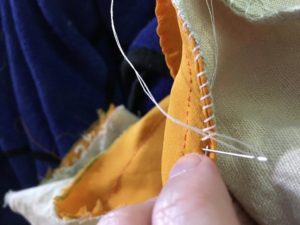
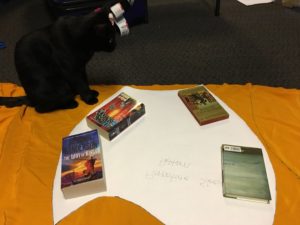
Tailor’s assistants are key to the process.
c. The Underskirt
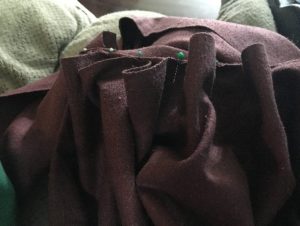
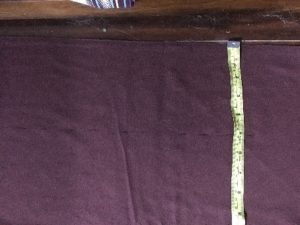
The underskirt is sewn out of raw silk. The center of the skirt features a box pleat surrounded by knife pleats, which was done to give the fullness and line seen in the example portraits. The seams were back stitched for stability. The waistband is whipstitched to the body of the skirt, and closes with a commercially purchased hook-and-eye enclosure.
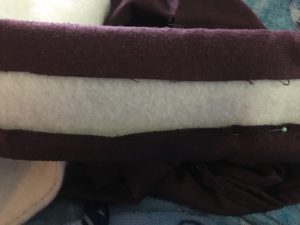
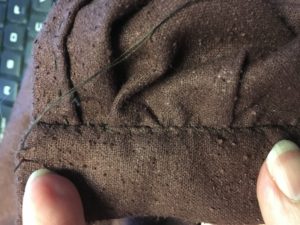
The wool felt stiffening is sewn to the hem of the skirt. The felt is sandwiched between two layers of matching raw silk, which is then attached to the underskirt to provide fullness. This is a documented Italian method called doppia. It requires that the wool be cut to match the circumference of the underskirt (in this case 104 total inches). Historically the doppia would have been made of a matching, but more luxurious, material. Unfortunately, I had nothing on hand that would qualify and so used additional pieces of the same cloth. This does demonstrate how much more opulent the technique makes the dress in terms of wealth as well as physical fullness.
d. Miscellaneous Pictures and Processes
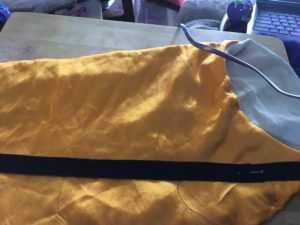

Figures 13 and 14 Attaching the velvet trim to the sleeve.

Figure 15 Using an awl to punch holes for the eyelets.
e. Finished Product
Below is a side-by-side comparison of the finished gown to the painting of St. John the Baptist. Francesco d’Ubertino (Il Bacchiacca), The Preaching of St. John the Baptist, Museum of Fine Arts (Budapest). https://commons.wikimedia.org/wiki/File:Bacchiacca_-_The_Preaching_of_Saint_John_the_Baptist_-_WGA1105.jpg
